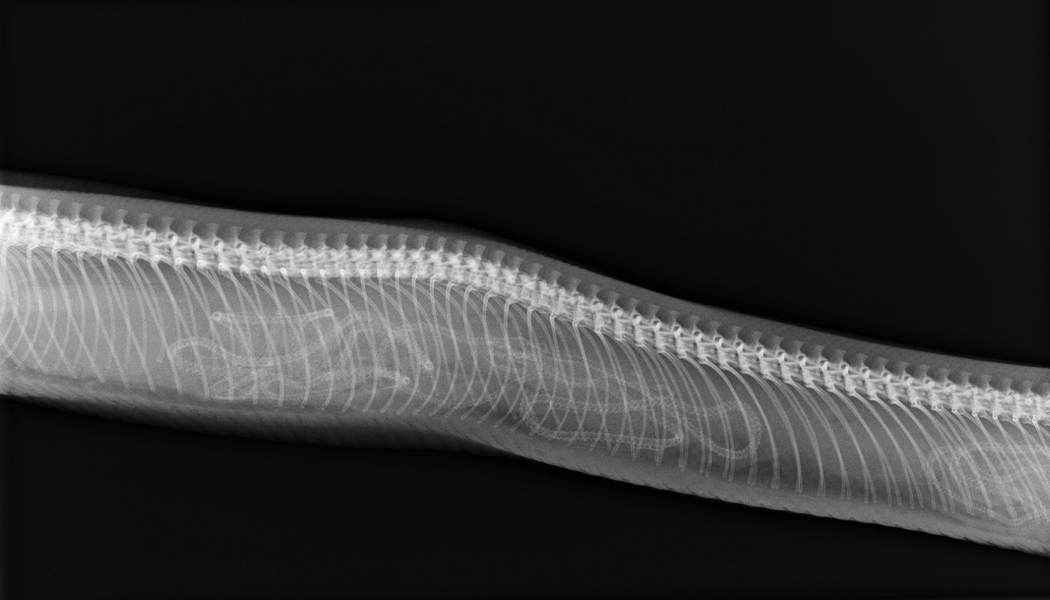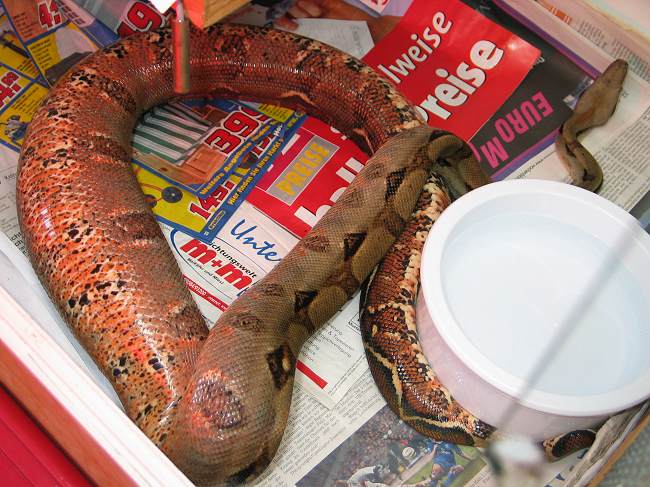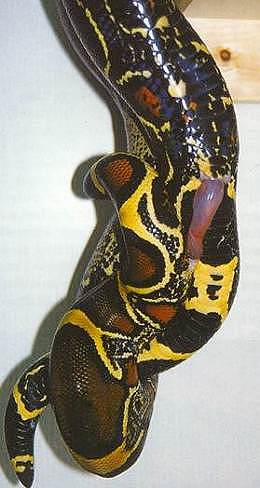Introducing the boas
Surinam redtail boas (Boa c. constrictor) are among the most difficult species of boas to successfully reproduce. One of the most successful breeders of these animals kept his breeder animals together for 12 months of the year. The male was in the cage even when the female was giving birth to the young.
We are aware of several successful breedings of other species of boas by other breeders that utilized a similar approach. In addition, we are also currently experimenting with a similar and very promising approach ourselves, and are therefore no longer certain that the male and female must be separated outside of the breeding season.
The permanent co-housing has one great advantage: The perfect point in time to introduce both sexes can no longer be missed. This results in neonates and hatchlings that are born at a time of the year, at which they are usually not born at all. This demonstrates that species that are regarded as seasonal (=mating and birth of the young occurs around the same time each year) may become unseasonal in captivity or have always been unseasonal. The belief in seasonality may even be the cause of a lack of successful breedings at times. If the animals are separated during the fertile months in the summer, because the breeder is convinced that fertility is given between October and March only, successful reproduction becomes unlikely.
People who prefer to house the animals separately outside of the mating season (like ourselves until recently) should be aware that it is better to place the female to the male rather than the other way around. As mentioned in an earlier section, the male’s willingness to breed is the bread and butter of successful reproduction. If the male is not motivated, then that’s it. It is therefore recommended to disturb or confuse him as little as possible. The transfer to another enclosure may already eliminate any motivation to mate with a female.
We believe that both separation and permanent co-housing of the two sexes has their own advantages and disadvantages in regard to propagation. Every keeper has to determine his/her own strategy to succeed.
Courtship behavior in Boa constrictor
When the male feels inclined to breed, he begins to crawl over the female and flicks his tongue at the body of his object of desire. The female usually tries to escape the intentions of the male by crawling away. This leads to a situation, in which the male chases the female through the enclosure until she no longer escapes. Once she finally holds still, the male coils his tail around hers and attempts to force the female to open her cloaca by scratching with his spurs, in order for him to introduce his hemipenis.
The sex organ of the male, the so-called hemipenis is y-shaped. One of the two ends is introduced into the cloaca of the female during copulation.
The female is usually not immediately ready for this. The male therefore attempts to get it anyways, by coiling the tail of the female with his tail and pressing both together in short intervals. Another medium to induce temptation is the scratching of the sides of the female’s body with the spurs. These very small nail-like structures can be found to the left and right of the male’s cloaca. They are the remainders of the rear extremities, which the snakes lost in the course of evolution. The spurs are much more developed in males than they are in females. Experienced boid keepers utilize this fact to determine the sex of adult specimens.
But back to the mating attempts of the male.
These can last for many hours and often end without success. Boid keepers will occasionally develop severe antipathies towards a female that refuses copulation for weeks or even months at a time.
We experienced the same in the beginning ourselves, until we realized that this behavior leads to the production of fertilizable eggs in the body of the female. Once the right point in time arrives, the female opens her cloaca and lets the male insert his hemipenis into it. As mentioned earlier, only one of the two ends of the hemipenis is inserted, the other one remains in the so-called hemipenial pocket.
Boa constrictor breeding information | Boa constrictor mating | Boa constrictor reproduction information | Boa constrictor gravidity | how to determine the sex of a Boa constricor | how to tell the sex of a boa | Boa constrictor probing | ovulation | sexual maturity | breeding season | how to tell if my boa is gravid | Boa constrictor giving birth | gestation period | brumation
Duration of the Co-housing in Boa constrictor
Potential breeders have unknowingly kept themselves from being successful by separating their snakes too early. Ovulation in the female is often associated with an enormous gain in body girth. To simply assume gravidity and to miss out on further copulations by separating the animals is the easiest way to receive a bunch of slugs from the female. This also raises the possibility of egg binding.
As we mentioned earlier, we know several successful breeders who keep both sexes together during the entire year, even while the female is gravid or giving birth. The risk of unknowingly keeping the animals from mating successfully by separating them too early is thereby eliminated entirely. If a separation of the breeder animals is desired, we recommend waiting at least three weeks after the last copulation was observed.
 x-ray photo of a gravid Hog Island boa. The x-ray was made because the female was eggbound.
x-ray photo of a gravid Hog Island boa. The x-ray was made because the female was eggbound.
Boa constrictor - signs of Gravidity
Gravid or not gravid, that is the question. Or how did it go in Shakespeare’s “Macbeth”?
Jokes aside. Every boid keeper who has observed mating of his/her animals will constantly observe the female and wonder whether she is gravid or not. We therefore want to take a look at the potential signs of gravidity:
Increase in girth
This increase in the girth of a gravid female snake is notable in the area shortly after the mid-body. While the increase in girth during ovulation only lasts a few days and then disappears again, it remains a constant condition during gravidity. However, even then the female sometimes appears to be a bit thinner, depending on how the eggs are positioned.
Refusal to feed
Gravid females often – though not always – refuse to feed. A reduced appetite is almost always notable. By the way, gravid females should also regularly be offered prey, even if they reject it for months at a time. At some point, they may want to have a snack in between. However, it is recommended to use fresh pre-killed or thawed rodents, in order to avoid unnecessary battles between the expecting mom and her prey. Rabbits and guinea pigs should be avoided altogether during this time, since the “abdominal area” of the gravid snake is already very occupied as far as space is concerned.
Reduced Activity
This is a sign that is almost always apparent. Once the boa or python is gravid, she usually becomes passive. Even our female Bahia Island boa (Boa c. imperator), who always used to disassemble her enclosure at night (4 “Repti-glo” fluorescent tubes are on her record) turned into a lazy snake and finally settled down, much to our joy. As punishment for destroying those fluorescent tubes, we sold her young.
We don’t want to omit the fact that there are some females who actually become more active when they are gravid. However, this is rather rare.
Seeking Hot Spots
A gravid boa or python has a greater desire for warmth, which the snake satisfies by frequently seeking the warmest spot in the enclosure for prolonged periods of time. An observant keeper will not miss such a change in behavior.
Darkening in Coloration
This is related to the increased desire for warmth as well. Gravid females almost always take on a darker coloration, which enables them to thermo-regulate more effectively.
 Gravid Boa constrictor females frequently turn their belly sidewards. Such a behaviour is a distinct sign of gravidity.
Gravid Boa constrictor females frequently turn their belly sidewards. Such a behaviour is a distinct sign of gravidity.
In the photo you can see a so-called "Firebelly Boa"

